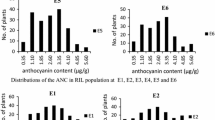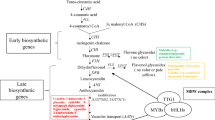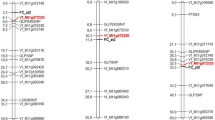Abstract
Anthocyanins have several biological functions in plants and are beneficial to human health. To elucidate the metabolic profile of anthocyanins and determine the genetic basis controlling anthocyanin accumulation in zicaitai (Brassica rapa L. ssp. chinensis var. purpurea), we conducted anthocyanin profile characterization and quantitative trait locus (QTL) analysis. Seventeen anthocyanin compounds were identified as cyanidin glycosides in zicaitai. A genetic linkage map based on 200 F2 lines was constructed using 161 insertion/deletion markers. Total anthocyanin content (TAC) was determined by pH differential spectrophotometry for the F2 lines. Using the map and phenotypic data, a major QTL which explained 56.7 % of phenotypic variation was identified for TAC on chromosome A09. Two genes, BrEGL3.1 and BrEGL3.2, as syntenic orthologs of AtEGL3 encoding basic helix–loop–helix transcription factors in this QTL region, are candidate genes for a key role in the control of anthocyanin accumulation in zicaitai.





Similar content being viewed by others
References
Andersen OM, Markham KR (2006) Flavonoids: chemistry, biochemistry and applications. CRC Press, Taylor & Francis, Boca Raton. 397-398
Bassam BJ, Caetano-Anolles G, Gresshoff PM (1991) Fast and sensitive silver staining of DNA in polyacrylamide gels. Anal Biochem 196(1):80–83
Broun P (2005) Transcriptional control of flavonoid biosynthesis: a complex network of conserved regulators involved in multiple aspects of differentiation in Arabidopsis. Curr Opin Plant Biol 8(3):272–279
Burdzinski C, Wendell DL (2007) Mapping the anthocyaninless (anl) locus in rapid-cycling Brassica rapa (RBr) to linkage group R9. BMC Genet 8(1):64
Burr FA, Burr B, Scheffler BE, Blewitt M, Wienand U, Matz EC (1996) The maize repressor-like gene intensifier1 shares homology with the r1/b1 multigene family of transcription factors and exhibits missplicing. Plant Cell 8(8):1249–1259
Chandler VL, Radicella JP, Robbins TP, Chen J, Turks D (1989) Two regulatory genes of the maize anthocyanin pathway are homologous: isolation of B utilizing R genomic sequences. Plant Cell 1(12):1175–1183
Chiu LW, Zhou X, Burke S, Wu X, Prior RL, Li L (2010) The purple cauliflower arises from activation of a MYB transcription factor. Plant Physiol 154(3):1470–1480
de Vetten N, Quattrocchio F, Mol J, Koes R (1997) The an11 locus controlling flower pigmentation in petunia encodes a novel WD-repeat protein conserved in yeast, plants, and animals. Genes Dev 11(11):1422–1434
Ferreres F, Valentão P, Pereira JA, Bento A, Noites A, Seabra RM, Andrade PB (2008) HPLC-DAD-MS/MS-ESI screening of phenolic compounds in Pieris brassicae L. reared on Brassica rapa var. rapa L. J Agric Food Chem 56(3):844–853
Goff SA, Cone KC, Chandler VL (1992) Functional analysis of the transcriptional activator encoded by the maize B gene: evidence for a direct functional interaction between two classes of regulatory proteins. Genes Dev 6(5):864–875
Gonzalez A, Zhao M, Leavitt JM, Lloyd AM (2008) Regulation of the anthocyanin biosynthetic pathway by the TTG1/bHLH/Myb transcriptional complex in Arabidopsis seedlings. Plant J 53(5):814–827
Grotewold E (2006) The genetics and biochemistry of floral pigments. Annu Rev Plant Biol 57:761–780
Grotewold E, Sainz MB, Tagliani L, Hernandez JM, Bowen B, Chandler VL (2000) Identification of the residues in the Myb domain of maize C1 that specify the interaction with the bHLH cofactor R. Proc Natl Acad Sci USA 97(25):13579–13584
Guo N, Cheng F, Wu J, Liu B, Zheng S, Liang J, Wang X (2014) Anthocyanin biosynthetic genes in Brassica rapa. BMC Genomics 15:426
Harborne JJB, Baxter H, Moss GP (1999) Phytochemical dictionary: a handbook of bioactive compounds from plants, 2nd edn. CRC Press, Boca Raton, pp 361–363
Hayashi K, Matsumoto S, Tsukazaki H, Kondo T (2010) Mapping of a novel locus regulating anthocyanin pigmentation in Brassica rapa. Breed Sci 60:76–80
Holton TA, Cornish EC (1995) Genetics and biochemistry of anthocyanin biosynthesis. Plant Cell 7(7):1071
Kim C, Park S, Kikuchi S, Kwon S, Park S, Yoon U, Park D, Seol Y, Hahn J, Park S (2010) Genetic analysis of gene expression for pigmentation in Chinese cabbage (Brassica rapa). BioChip J 4(2):123–128
Kim C, Kim J, Kikuchi S, Choi J, Kim Y, Park H, Seol Y, Park D, Hahn J, Kim Y (2011) Computational identification of Chinese cabbage anthocyanin-specific genes. Biochip J 5(2):184–192
Koes R, Verweij W, Quattrocchio F (2005) Flavonoids: a colorful model for the regulation and evolution of biochemical pathways. Trends Plant Sci 10(5):236–242
Kosambi DD (1944) The estimation of map distances from recombination values. Ann Eugen 12(1):172–175
Lam TK, Gallicchio L, Lindsley K, Shiels M, Hammond E, Tao XG, Chen L, Robinson KA, Caulfield LE, Herman JG (2009) Cruciferous vegetable consumption and lung cancer risk: a systematic review. Cancer Epidemiol Biomark Prev 18(1):184–195
Lee J, Durst RW, Wrolstad RE (2005) Determination of total monomeric anthocyanin pigment content of fruit juices, beverages, natural colorants, and wines by the pH differential method: collaborative study. J AOAC Int 88(5):1269–1278
Lin LZ, Harnly JM (2007) A screening method for the identification of glycosylated flavonoids and other phenolic compounds using a standard analytical approach for all plant materials. J Agric Food Chem 55(4):1084–1096
Lin LZ, Sun J, Chen P, Harnly J (2011) UHPLC-PDA-ESI/HRMS/MSn analysis of anthocyanins, flavonol glycosides, and hydroxycinnamic acid derivatives in red mustard greens (Brassica juncea Coss Variety). J Agric Food Chem 59(22):12059–12072
Liu B, Wang Y, Zhai W, Deng J, Wang H, Cui Y, Cheng F, Wang X, Wu J (2013a) Development of InDel markers for Brassica rapa based on whole-genome re-sequencing. Theor Appl Genet 126(1):231–239
Liu J, Wang W, Zhang D, Yu S, Zhang F, Zhao X, Yu J, Lu G (2013b) Primary mapping of pur, a gene controlling purple leaf color in Brassica rapa. Acta Agric Boreal Sin 28(1):49–53 (in Chinese)
Lo Scalzo R, Genna A, Branca F, Chedin M, Chassaigne H (2008) Anthocyanin composition of cauliflower (Brassica oleracea L. var. botrytis) and cabbage (B. oleracea L. var. capitata) and its stability in relation to thermal treatments. Food Chem 107(1):136–144
Longo L, Vasapollo G (2006) Extraction and identification of anthocyanins from Smilax aspera L. berries. Food Chem 94(2):226–231
Ludwig SR, Wessler SR (1990) Maize R gene family: tissue-specific helix-loop-helix proteins. Cell 62(5):849–851
Mazza G, Miniati E (1993) Anthocyanins in fruits, vegetables, and grains. CRC Press, Boca Raton
Mobin M, Khan NA (2007) Photosynthetic activity, pigment composition and antioxidative response of two mustard (Brassica juncea) cultivars differing in photosynthetic capacity subjected to cadmium stress. J Plant Physiol 164(5):601–610
Moreno DA, Pérez-Balibrea S, Ferreres F, Gil-Izquierdo Á, García-Viguera C (2010) Acylated anthocyanins in broccoli sprouts. Food Chem 123(2):358–363
Nesi N, Debeaujon I, Jond C, Pelletier G, Caboche M, Lepiniec L (2000) The TT8 gene encodes a basic helix-loop-helix domain protein required for expression of DFR and BAN genes in Arabidopsis siliques. Plant Cell 12(10):1863–1878
Park KI, Ishikawa N, Morita Y, Choi JD, Hoshino A, Iida S (2007) A bHLH regulatory gene in the common morning glory, Ipomoea purpurea, controls anthocyanin biosynthesis in flowers, proanthocyanidin and phytomelanin pigmentation in seeds, and seed trichome formation. Plant J 49(4):641–654
Paz-Ares J, Ghosal D, Wienand U, Peterson P, Saedler H (1987) The regulatory c1 locus of Zea mays encodes a protein with homology to myb proto-oncogene products and with structural similarities to transcriptional activators. The EMBO J 6(12):3553
Podsędek A (2007) Natural antioxidants and antioxidant capacity of Brassica vegetables: a review. LWT-Food Sci Technol 40(1):1–11
Prior RL, Wu XL (2006) Anthocyanins: structural characteristics that result in unique metabolic patterns and biological activities. Free Radic Res 40(10):1014–1028
Quattrocchio F, Wing J, van der Woude K, Souer E, de Vetten N, Mol J, Koes R (1999) Molecular analysis of the anthocyanin2 gene of petunia and its role in the evolution of flower color. Plant Cell 11(8):1433–1444
Scalzo RL, Genna A, Branca F, Chedin M, Chassaigne H (2008) Anthocyanin composition of cauliflower (Brassica oleracea L. var. botrytis) and cabbage (B. oleracea L. var. capitata) and its stability in relation to thermal treatments. Food Chem 107(1):136–144
Sweeney MT, Thomson MJ, Pfeil BE, McCouch S (2006) Caught red-handed: Rc encodes a basic helix-loop-helix protein conditioning red pericarp in rice. Plant Cell 18(2):283–294
Tanaka Y, Sasaki N, Ohmiya A (2008) Biosynthesis of plant pigments: anthocyanins, betalains and carotenoids. Plant Journal 54(4):733–749
Tatsuzawa F, Saito N, Shinoda K, Shigihara A, Honda T (2006) Acylated cyanidin 3-sambubioside-5-glucosides in three garden plants of the Cruciferae. Phytochemistry 67(12):1287–1295
Van Ooijen JW (2004) MapQTL5, software for mapping of quantitative trait loci in experimental populations. Kyazma BV, Wageningen
Van Ooijen JW (2006) JoinMap4, software for the calculation of genetic linkage maps in experimental populations. Kyazma BV, Wageningen
van Poppel G, Verhoeven DT, Verhagen H, Goldbohm RA (1999) Brassica vegetables and cancer prevention. In: Zappia V, Della Ragione F, Barbarisi A, Russo GL, Iacovo RD (eds) Advances in nutrition and cancer 2. Springer, pp 159–168
Wang X, Lou P, Bonnema G, Yang B, He H, Zhang Y, Fang Z (2005) Linkage mapping of a dominant male sterility gene Ms-cd1 in Brassica oleracea. Genome 48(5):848–854
Wang Y, Sun S, Liu B, Wang H, Deng J, Liao Y, Wang Q, Cheng F, Wang X, Wu J (2011) A sequence-based genetic linkage map as a reference for Brassica rapa pseudochromosome assembly. BMC Genomics 12(1):239
Wu X, Prior RL (2005) Systematic identification and characterization of anthocyanins by HPLC-ESI-MS/MS in common foods in the United States: fruits and berries. J Agric Food Chem 53(7):2589–2599
Yamasaki H, Sakihama Y, Ikehara N (1997) Flavonoid-peroxidase reaction as a detoxification mechanism of plant cells against H2O2. Plant Physiol 115(4):1405–1412
Zhang F, Gonzalez A, Zhao M, Payne CT, Lloyd A (2003) A network of redundant bHLH proteins functions in all TTG1-dependent pathways of Arabidopsis. Development 130(20):4859–4869
Acknowledgments
The work was funded by the National High Technology R&D Program of China (2012AA100101); the National Program on Key Basic Research Projects of China (The 973 Program: 2012CB113900, 2013CB127000, and 2013CB127006); the International Joint Research Grant of Ministry of Science and Technology, P.R. China (2011DFR31180); and the National Natural Science Foundation of China (NSFC Grants: 31301771, 31201628, 31201636 and 31301784); the Key Laboratory of Biology and Genetic Improvement of Horticultural Crops, Ministry of Agriculture, P.R. China and the Sino-Dutch Joint Lab of Horticultural Genomics Technology as well as the National Engineering Research Center for Vegetables in Beijing.
Author information
Authors and Affiliations
Corresponding author
Electronic supplementary material
Below is the link to the electronic supplementary material.
11032_2015_237_MOESM2_ESM.jpg
Supplementary Fig. S1 Amino acid sequence alignment and comparison of BrEG3.1 and BrEGL3.2 showing amino acid substitutions of the parental lines. Identical residues are highlighted on a black background, and similar residues are highlighted on a gray background (JPEG 329 kb)
Rights and permissions
About this article
Cite this article
Guo, N., Wu, J., Zheng, S. et al. Anthocyanin profile characterization and quantitative trait locus mapping in zicaitai (Brassica rapa L. ssp. chinensis var. purpurea). Mol Breeding 35, 113 (2015). https://doi.org/10.1007/s11032-015-0237-1
Received:
Accepted:
Published:
DOI: https://doi.org/10.1007/s11032-015-0237-1




